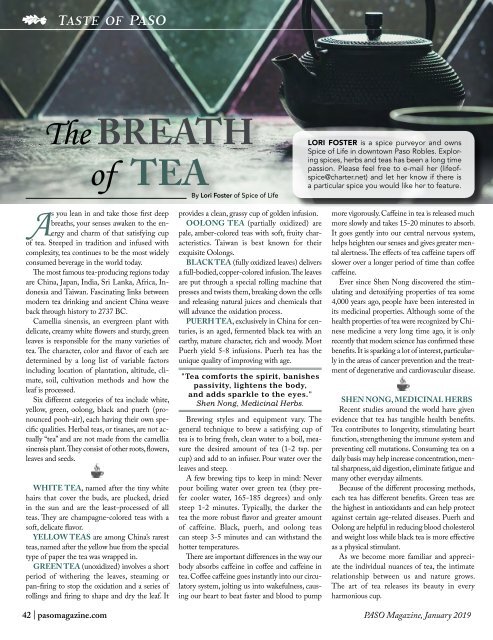2019 January Paso Robles Magazine
The Story of Us — a Monthly Look at Our Remarkable Community
The Story of Us — a Monthly Look at Our Remarkable Community
Create successful ePaper yourself
Turn your PDF publications into a flip-book with our unique Google optimized e-Paper software.
The BREATH<br />
of TEABy Lori Foster of Spice of Life<br />
LORI FOSTER is a spice purveyor and owns<br />
Spice of Life in downtown <strong>Paso</strong> <strong>Robles</strong>. Exploring<br />
spices, herbs and teas has been a long time<br />
passion. Please feel free to e-mail her (lifeofspice@charter.net)<br />
and let her know if there is<br />
a particular spice you would like her to feature.<br />
As you lean in and take those first deep<br />
breaths, your senses awaken to the energy<br />
and charm of that satisfying cup<br />
of tea. Steeped in tradition and infused with<br />
complexity, tea continues to be the most widely<br />
consumed beverage in the world today.<br />
The most famous tea-producing regions today<br />
are China, Japan, India, Sri Lanka, Africa, Indonesia<br />
and Taiwan. Fascinating links between<br />
modern tea drinking and ancient China weave<br />
back through history to 2737 BC.<br />
Camellia sinensis, an evergreen plant with<br />
delicate, creamy white flowers and sturdy, green<br />
leaves is responsible for the many varieties of<br />
tea. The character, color and flavor of each are<br />
determined by a long list of variable factors<br />
including location of plantation, altitude, climate,<br />
soil, cultivation methods and how the<br />
leaf is processed.<br />
Six different categories of tea include white,<br />
yellow, green, oolong, black and puerh (pronounced<br />
pooh-air), each having their own specific<br />
qualities. Herbal teas, or tisanes, are not actually<br />
“tea” and are not made from the camellia<br />
sinensis plant. They consist of other roots, flowers,<br />
leaves and seeds.<br />
WHITE TEA, named after the tiny white<br />
hairs that cover the buds, are plucked, dried<br />
in the sun and are the least-processed of all<br />
teas. They are champagne-colored teas with a<br />
soft, delicate flavor.<br />
YELLOW TEAS are among China’s rarest<br />
teas, named after the yellow hue from the special<br />
type of paper the tea was wrapped in.<br />
GREEN TEA (unoxidized) involves a short<br />
period of withering the leaves, steaming or<br />
pan-firing to stop the oxidation and a series of<br />
rollings and firing to shape and dry the leaf. It<br />
provides a clean, grassy cup of golden infusion.<br />
OOLONG TEA (partially oxidized) are<br />
pale, amber-colored teas with soft, fruity characteristics.<br />
Taiwan is best known for their<br />
exquisite Oolongs.<br />
BLACK TEA (fully oxidized leaves) delivers<br />
a full-bodied, copper-colored infusion. The leaves<br />
are put through a special rolling machine that<br />
presses and twists them, breaking down the cells<br />
and releasing natural juices and chemicals that<br />
will advance the oxidation process.<br />
PUERH TEA, exclusively in China for centuries,<br />
is an aged, fermented black tea with an<br />
earthy, mature character, rich and woody. Most<br />
Puerh yield 5-8 infusions. Puerh tea has the<br />
unique quality of improving with age.<br />
"Tea comforts the spirit, banishes<br />
passivity, lightens the body,<br />
and adds sparkle to the eyes."<br />
Shen Nong, Medicinal Herbs.<br />
Brewing styles and equipment vary. The<br />
general technique to brew a satisfying cup of<br />
tea is to bring fresh, clean water to a boil, measure<br />
the desired amount of tea (1-2 tsp. per<br />
cup) and add to an infuser. Pour water over the<br />
leaves and steep.<br />
A few brewing tips to keep in mind: Never<br />
pour boiling water over green tea (they prefer<br />
cooler water, 165-185 degrees) and only<br />
steep 1-2 minutes. Typically, the darker the<br />
tea the more robust flavor and greater amount<br />
of caffeine. Black, puerh, and oolong teas<br />
can steep 3-5 minutes and can withstand the<br />
hotter temperatures.<br />
There are important differences in the way our<br />
body absorbs caffeine in coffee and caffeine in<br />
tea. Coffee caffeine goes instantly into our circulatory<br />
system, jolting us into wakefulness, causing<br />
our heart to beat faster and blood to pump<br />
more vigorously. Caffeine in tea is released much<br />
more slowly and takes 15-20 minutes to absorb.<br />
It goes gently into our central nervous system,<br />
helps heighten our senses and gives greater mental<br />
alertness. The effects of tea caffeine tapers off<br />
slower over a longer period of time than coffee<br />
caffeine.<br />
Ever since Shen Nong discovered the stimulating<br />
and detoxifying properties of tea some<br />
4,000 years ago, people have been interested in<br />
its medicinal properties. Although some of the<br />
health properties of tea were recognized by Chinese<br />
medicine a very long time ago, it is only<br />
recently that modern science has confirmed these<br />
benefits. It is sparking a lot of interest, particularly<br />
in the areas of cancer prevention and the treatment<br />
of degenerative and cardiovascular disease.<br />
SHEN NONG, MEDICINAL HERBS<br />
Recent studies around the world have given<br />
evidence that tea has tangible health benefits.<br />
Tea contributes to longevity, stimulating heart<br />
function, strengthening the immune system and<br />
preventing cell mutations. Consuming tea on a<br />
daily basis may help increase concentration, mental<br />
sharpness, aid digestion, eliminate fatigue and<br />
many other everyday ailments.<br />
Because of the different processing methods,<br />
each tea has different benefits. Green teas are<br />
the highest in antioxidants and can help protect<br />
against certain age-related diseases. Puerh and<br />
Oolong are helpful in reducing blood cholesterol<br />
and weight loss while black tea is more effective<br />
as a physical stimulant.<br />
As we become more familiar and appreciate<br />
the individual nuances of tea, the intimate<br />
relationship between us and nature grows.<br />
The art of tea releases its beauty in every<br />
harmonious cup.<br />
42 | pasomagazine.com PASO <strong>Magazine</strong>, <strong>January</strong> <strong>2019</strong>

















